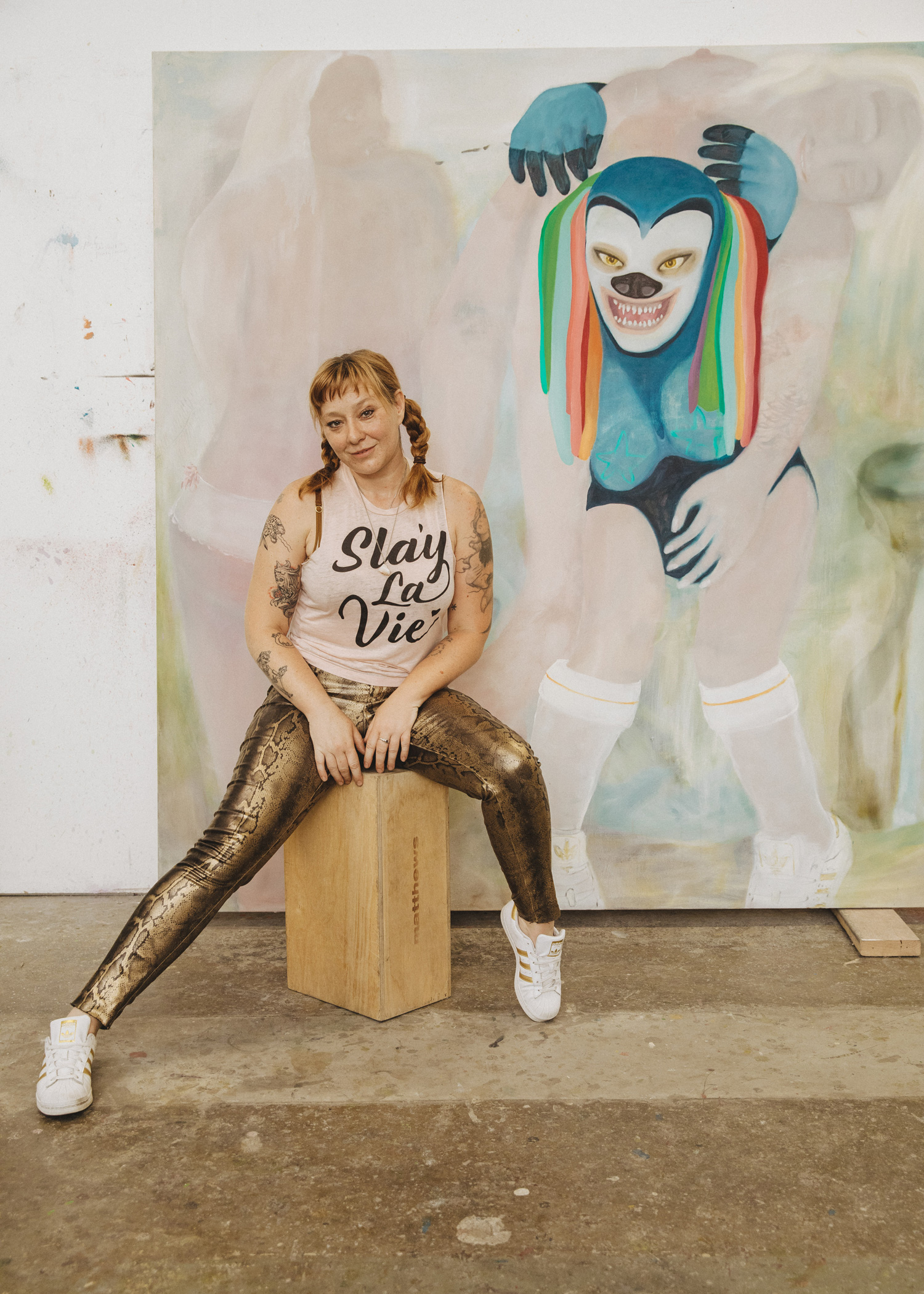The first time I met Lydia Maria Pfeffer, she was graciously welcoming people into her show at Ochi Project in Los Angeles. Holding a fur hat and donning a warm smile, Pfeffer swiftly moved around the room urging people to reach deep into the hat and blindly pick one of her “guidance cards,” a pocket-sized drawing made with India ink that depicted one of her fantastical characters. I reached in and drew a card that portrayed a frolicking female with long, claw-like talons, hoop earrings, a curvy figure, and a ravenous but unthreatening expression. Pfeffer smiled, explained that the figure was “dancing big” and that I should follow suit and do the same in my own life. It was no more than a thirty-second interaction, but Pfeffer’s emphatic energy was rousing.
It was the same energy that she welcomed me with when I arrived at her studio almost six months later. It was a hot summer day, and like our first interaction, Pfeffer moved about the space with confidence, introducing me to the life-size figures that inhabited each of her massive paintings. As Pfeffer dove into the characteristics and mannerisms of each painted figure — an androgynous being wearing a bikini and heart-shaped glasses, a female character with multicolored dreads and tube socks — I started to realize that this exaggerated cast of gender-bending creatures was Pfeffer’s way of revealing parts of herself. Paws, teeth, and other fabulous and not entirely human traits act as a buffer for Pfeffer to explore the absurdity of human existence through her own reinvented mythology.
You recently were part of a group show, right?
Yes, I participated in the Kamikaze Series which is a Los Angeles institution. It runs for a whole month, with a new show every single night—different curators, different artists. It goes up and then the same day comes down. It’s all pretty much artists curating so it’s really exciting to be part of the tenth show, the tenth year, and that was last night so we literally just installed the show yesterday and then took it down at the end of the night.
That’s awesome, there’s something I love about something so temporary. Where the show is literally up for a day, not even a full twenty-four hours.
I think it’s very much a part of the Los Angeles landscape in every way, not just the artistic way. It’s kind of like how you see the people in the streets selling tamales or tacos, and yes a lot of them have their regular spot, but it goes up and it comes down every day and night. I wasn’t a big fan of pop-ups in other places, but in LA for some reason, it just makes sense because it’s part of the culture here. It’s nice to meet new people, new artists, and work with artists you’ve never worked with before. Everyone pulls together and it’s not necessarily about monetary gain. It’s just about getting things done and working together. It’s community building.

That’s a constant theme I encountered here in Los Angeles. I was born and raised here. I started the magazine when I was living in Boston, but it’s flourished here in Los Angeles. I think it’s because there’s such a large community of people that are willing to be part of something devoid of ego and feel like they’re part of a larger community of creatives. I think that’s a lot of what the artist community here in Los Angeles is, friends, working together and pushing each other to go forward and progress.
Yes, I have found that too. I moved here three years ago and I noticed, especially back then when BBQLA was still going, those spaces helped us out when we got here. People were so helpful and embraced us, or embraced me and it was a nice feeling. It was a lot of people just helping each other out. I’ve lived in a lot of different cities—London, New York, Chicago—and I love all these places, but it stuck out to me here, that people will help each other or try to build something together. Which is interesting because the city is so spread out. Maybe that is our way of balancing the vast topography with the urge to be around people. It can get lonely here because you have to drive everywhere, you have to make the effort to see people, right? I’ve never lived in a place where people drive to ten openings in different neighborhoods in one night because they want to see friends or they want to see the show. In some places, people won’t even leave their neighborhood, but here, people go from Glendale to Culver City to Lincoln Heights.
So you moved here three years ago. Where were you before this?
Before Los Angeles, I was in Chicago for two years. I went to grad school at SAIC. It wasn’t a place that I ever thought about living or doing my grad program in, it just happened that way. I was living in New York for eleven years—I did my undergrad in New York. I needed to get out of New York because I was there for a long time and the rat race kind of got to me. I wanted to see if I was really done with New York or if I just needed a little break, so I thought grad school was a great way to leave the city. Initially, I wanted to come back to New York right away, then I started loving Chicago and found a great family there. I did a study trip out to LA and there were so many incredibly strong women that we met and that Terry Myers introduced us to, like Frances Stark at the Hammer and Rebecca Morris. What stuck out to me is that there were a lot of women doing their thing here and the landscape itself is incredible. I grew up in a tiny village in Austria in the mountains, so this is like a vacation place to me where you come to be with palm trees and things like that.
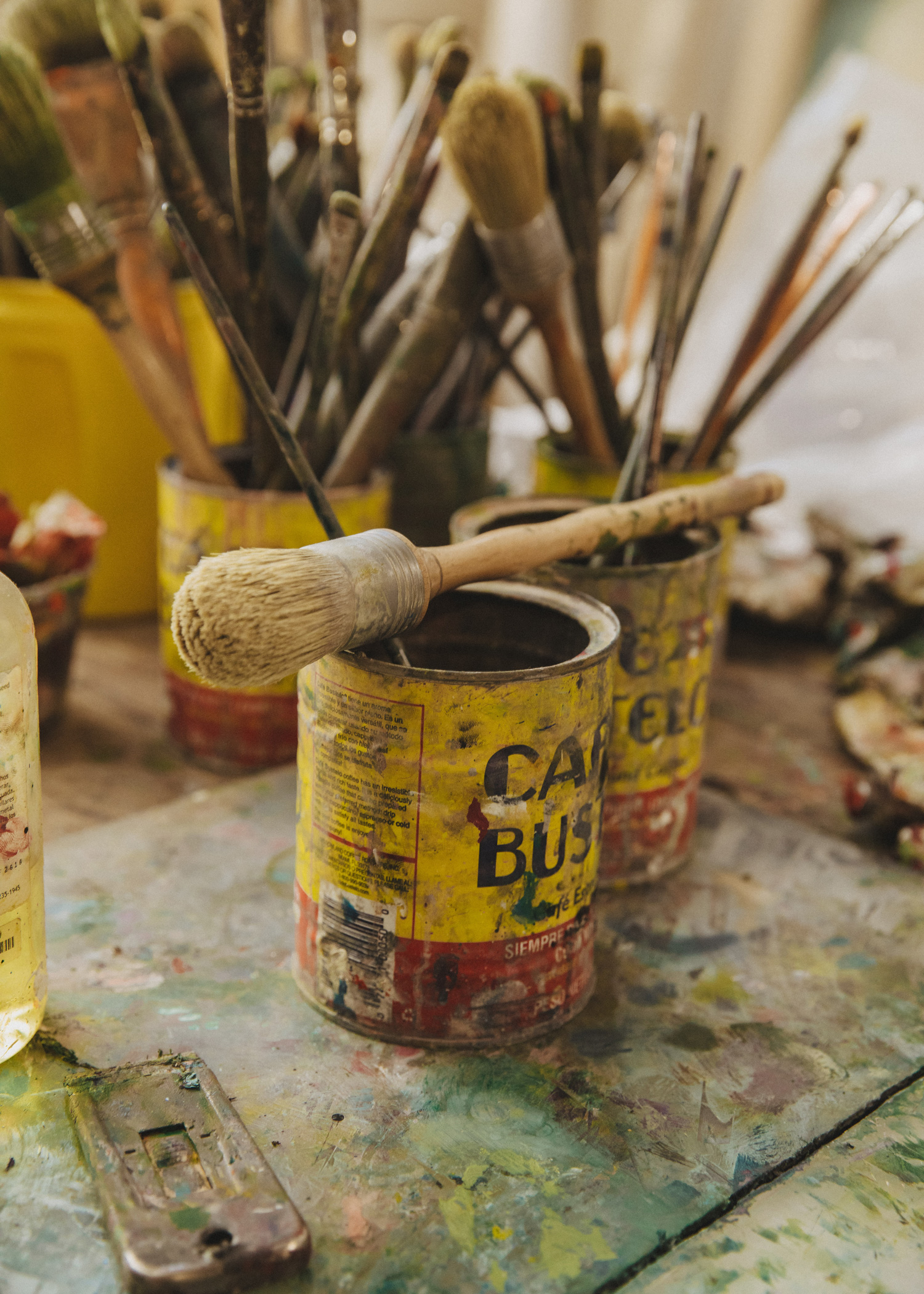
Tell me about where you grew up. It was a very small town in Austria, a mountain town?
Yes, 500 people. It’s a village, it’s not a town. I think at the time I was living there it was like 800 people, now it’s 500.
Does your family still live there?
My family still lives there, I’m the only person that lives in another country or abroad. I grew up in a Roman Catholic village that has a lot of rich history with regard to hiding from prosecution. There is also a lot of Paganism in the village, so you have this strange fusion of Roman Catholics and Pagans. Nature and the mountains and forests that surround the village where I grew up are such a big part of life, they’re almost regarded as deities. There’s a whole sense of reverence and respect for them. Even the Austrian national flower, the Edelweiss, is held in the same regard. If somebody wanted to get a girl, for example, it grows in the most dangerous places and people would risk their lives to get that flower, but you have to get this strange blessing from the mountain to even get it or know that mountain and risk it all. There’s just vast respect for nature and the mountains we inhabit.
Tell me more about the people that inhabit your village and that strange dichotomy between Catholicism and Paganism.
Mountain folk tend to be a little on the coarse side because that’s just the nature of things. They are also very passionate. On the one hand, it’s very conservative, but then you have this undercurrent of extreme, hidden hedonism that’s not allowed except for a couple of times a year when we start celebrating carnival, which is one of my favorite holidays because everyone suddenly starts crossdressing. The farmer from down the block will start running around in heels and everything, and it’s the best thing ever because masks and costumes show you a different side of a person and what they desire, who they want to be or what they’re afraid of. I believe in escapism as a revelation. It’s the one festivity where everybody is allowed to be whoever they want to be. I feel like it is a release, breaking the chains of all the very conservative Roman Catholic ways of living and thinking. My family is religious, but not as much as other people are. My mom never forced me to go to church. I also learned a lot in church though—if you look at all the get-ups in the Roman Catholic church, you will find a lot of these things in my work too. Certain types of influences from my upbringing haven’t been lost. You don’t just stop being a Catholic even if you don’t go to church. There’s so much that’s ingrained in your head.

How were you first introduced to art?
I grew up in a very musical household. My entire family and extended family are very musical. A lot of them play instruments, everything from the sitar to acoustic guitar to classical piano to trumpet and other horn instruments. Everything was done in the traditional sense though—some played in the local traditional band, or sang in the choir, which I used to do. But art was never spoken about as a career or as something that you could do professionally. It was only done in a traditional sense, similar to folk art where you make things, you decorate stuff and everything is very creative but not in a fine art sense. I grew up with a lot of creativity, my mom and my grandma would do a lot of things themselves. My mom spins wool, plays the sitar, and does a lot of baking.
My parents sent me to school for hotel and office management because they wanted me to have a job that made money and you make money with tourism. I don’t come from a wealthy family so they weren’t able to say, “Yeah, go to art school.” It was more about needing to learn something practical. I eventually left Austria after school because it was just not what I wanted to do and I went to London and started making music more seriously, became a performer, had a band, and cut a demo. My parents started to get a little worried, but I still was in the restaurant business so the education that they gave me did help me because I was able to pick up jobs wherever I went. Everybody needs a waiter or a bartender. But, you know, they were a little worried because they thought pursuing music professionally was crazy. I eventually moved to New York and realized I didn’t want it hard enough anymore. I had always been drawing and making things since I was very young. When I found the clay in the river behind that house I would try to make something with it, or would just draw. My mom just sent me a whole bunch of drawings from when I was a kid.

What are those drawings like?
It’s very interesting because the themes have not changed from then until now, which is kind of crazy. I’ve always been interested in anthropomorphic beings, my first love was Egyptology. Anything that had an animal head on a human body. Shapeshifting was always just the most curious and most magical thing to me. My subjects and underlying themes haven’t changed much, they’ve just evolved. When I went to New York, I went through a bit of a rough patch in many ways, in very unhealthy ways—speaking of hedonism—and I needed to reel myself back in. I wanted to go do what I always wanted to do and that was to go to art school. I applied to the painting program, but everything I submitted was drawings. I remember during my interview process they asked me why I didn’t apply to the illustration program. I told him I didn’t know, but that I just wanted to see if I was any good at painting. When I started the program I initially thought I would be a sculptor actually, because I took to sculpting and 3D. Then I had my first painting class and I cried and I threw things and I was frustrated, and yet I couldn’t put the brush down. It was the most infuriating and frustrating thing I’ve ever done in my life, but it was also the most addictive, the most fulfilling. Ever since then, it hasn’t stopped.
Do you still find the process frustrating at times?
Absolutely, a few weeks ago I sat in that very chair, which you are sitting in, and for an entire week I just stared at a semi-blank canvas and complained to all of my friends that I didn’t know how to paint anymore and that I had lost all of my ability to paint, it was all a fluke. I had this diva meltdown. You start having these thoughts about how much you put in—seven days a week in the studio every day, and not just sitting here and doodling all happy—it takes so much commitment. I think a lot of people don’t understand how much work it takes emotionally, even physically. It’s a self-absorbed process in certain ways, not for all artists, but you know, if you are painting in a studio by yourself, you need to get to know yourself pretty well. You try to extract what you can give or what you can show to the world, so it’s not only about you, but also about what is deep down inside that drives you to make these things. My paintings are all about connection. They’re all about touching, connecting, and loving. They seem monstrous in a lot of ways, but they are about relationships. I want people to look at them and observe and hear people’s reactions to them.
But yes, I still have these very frustrating moments, they’re real. It’s all about the long game. Who can hang in there the longest? How long can you do this and not just forfeit everything for a full-time job and some health benefits and a nice apartment and all these things?
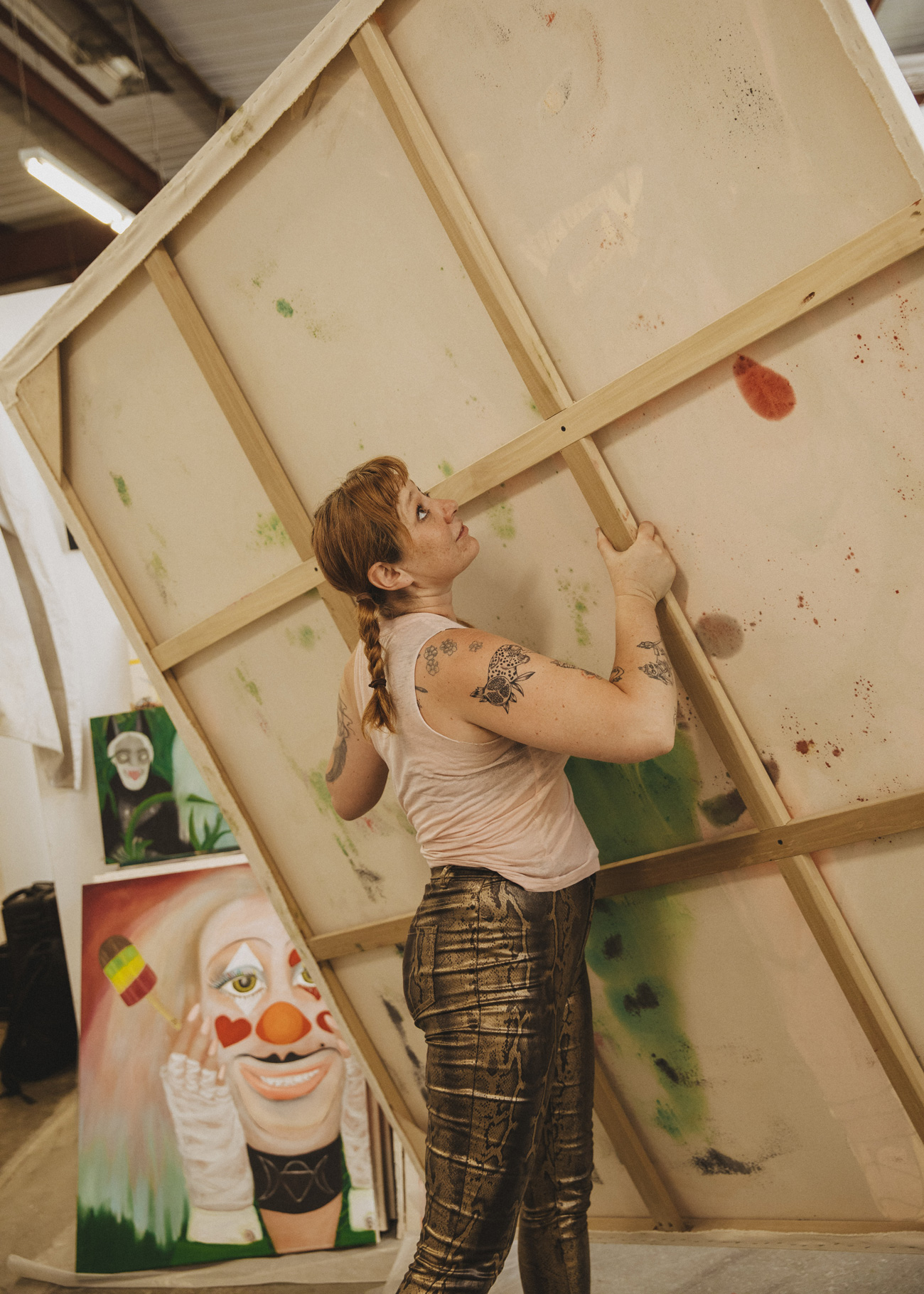
What keeps you coming into the studio every day?
I honestly sometimes don’t know. I wish I could answer that question because it’s kind of insane. Jerry Saltz says it all the time, “If you don’t have to be an artist don’t be one.” You’re making all of these things, there’s no guaranteed return, you might sit on these paintings for twenty years and you might be broke every single day and do shows and still not make money. But there’s something about when I come in here that I just get lost. I keep doing it even though sometimes I feel hopeless or I feel it’s not going to work out. I’m persistent and all of a sudden something gives itself over to me and starts appearing and starts rewarding me because this is how these paintings are made, they’re made intuitively. There are no sketches. It’s just the dialogue between me and the canvas. So once that starts happening and these figures are coming out and things are appearing, it’s the most insane feelings of gratitude, joy, and happiness. The world makes sense all of a sudden. Everything makes sense.
Like things have fallen into place.
Exactly. It’s like I understand the world better—the world that we see, the world that we don’t see, and I feel like I belong and there’s a sense of connection. That’s really why I keep coming back to the canvas. It leads me down this path and makes me want to keep seeking for that treasure. It’s a treasure hunt and the rewards, they don’t have to be monetary they literally can be spiritual, where it makes you feel so good that you made a painting.
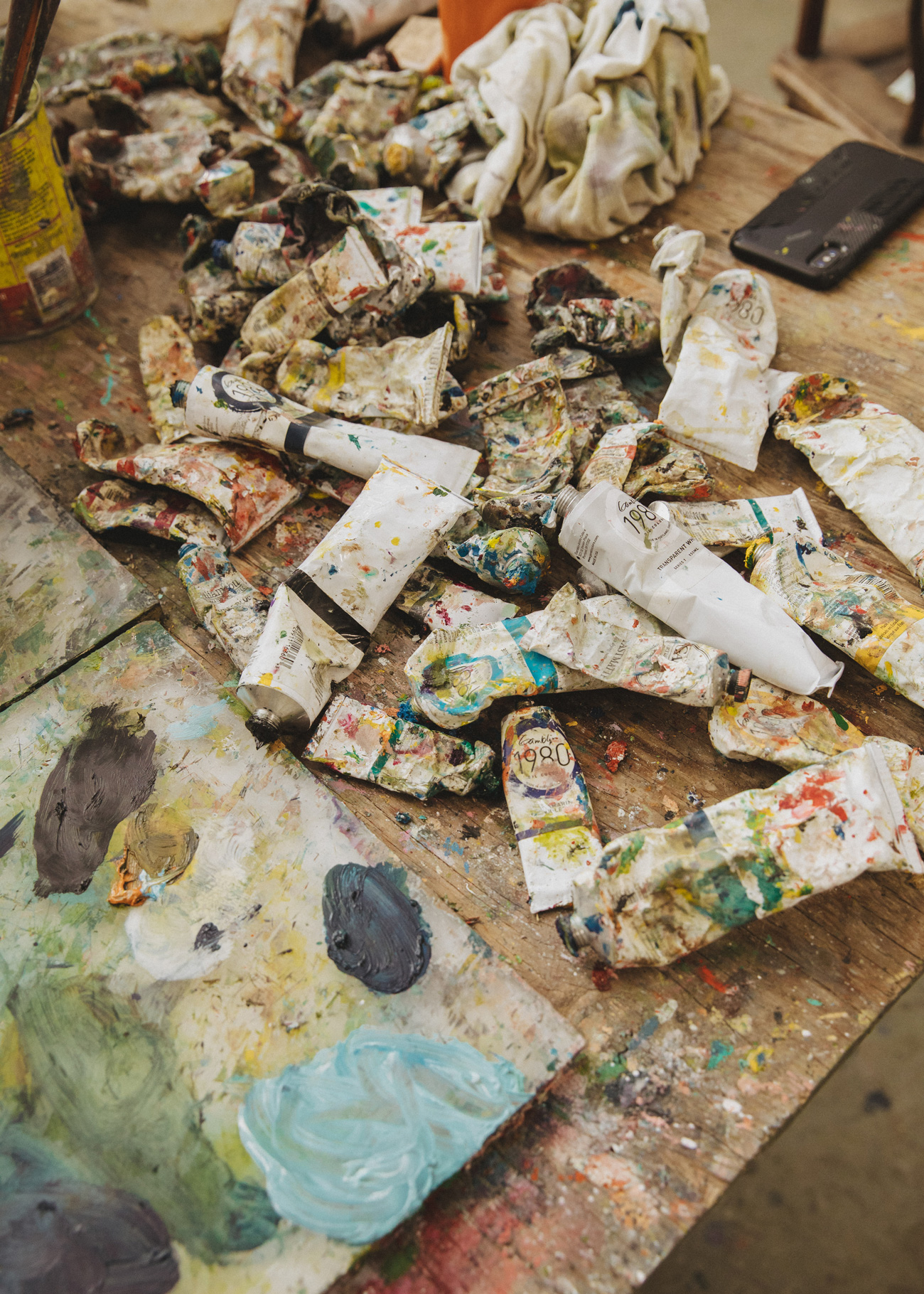
Tell me about some of the creatures and figures in these pieces. Who are they?
Women have become protagonists in my paintings more and more. I think it might be part of the aging process for me; I’m figuring out how I function as a fully-grown woman and how to negate a very ageist world. I think it’s easier for me to paint these anthropomorphic beings or these creatures because humans can be very cruel and very difficult. These beings are fun to paint because they have paws and teeth and other fabulous things, but they’re also a buffer. I get to express myself a lot more with them not being entirely human, than if I just paint people the way we understand people. I like to think that although these are creatures with exaggerated traits, people can still connect and see themselves in these figures. There’s a lot of gender-bending in these creatures; sometimes sex is exaggerated or sometimes you’re not quite sure if they are a female or male character. The fewer restrictions, the freer you are to paint certain things.
Of course, I am psychologically and socially conditioned, all these beings are coming from some construct in my psyche, but there is something about trying to break these rules and affording these creatures freedom that I don’t feel we have as humans. I address the inversion of what’s beautiful, what’s scary. To me, none of these things are scary, but I have people coming into the studio all the time saying it’s terrifying. To me they are endearing and they’re goofy and they’re weird. Generally, these creatures are just outcasts that like to have fun. They’re unapologetic and they’re not looking for your approval. It’s me acting out on canvas, giving myself a lot of freedom. Everybody lives within their own social conditions and there are many differences in the world, but I think these paintings are more focused on the similarities or what we all have in common. I’m a big believer in Jung’s theory of the collective unconscious—you can go into any tribe or any culture and find a very similar spirit, it just looks different. The manifestation of it may be different, but it evokes the same fear, it evokes the same love, it evokes the same awe… it’s cautionary for the same reason.
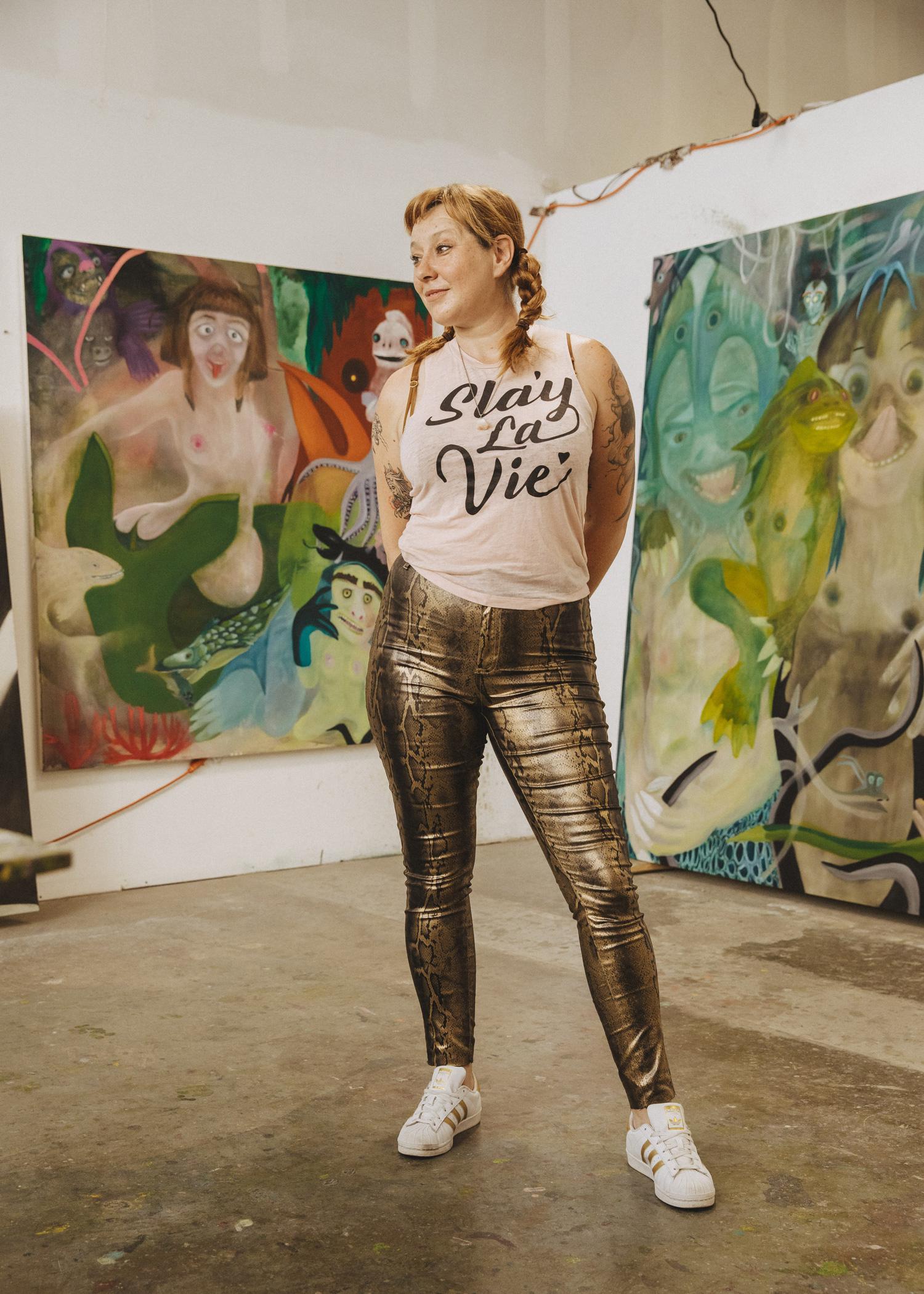
I like how you mentioned that these protagonists aren’t asking for approval. You can tell, they always have some kind of sly little smile on, and also in the way that they’re posed. I feel like you function under that same ethos.
Well when you’re a troubled teenager that leaves home at nineteen and moves to a different country, you become a very strong-willed person. I had to work hard my entire life though—with every new place I moved I had to start over and learn to survive and take care of myself. You have to be flexible, but also very stubborn. You have to get to know yourself and be who you are because if you know who you are, you can protect yourself a little bit better. You have to find your authenticity and your worth. You’re right, I do live my life unapologetically. I like to apologize generally because I have this weird thing where I’m always sorry about something and I have a lot of guilt, my lovely Catholic upbringing. But at the end of the day, I know that my actions are never malicious. I’m not trying to harm anyone. I’m not trying to prove anything to anyone. It’s really about not apologizing for who you are. Part of my journey is to learn to accept myself and I think these paintings and these creatures are helping me do so. I hope that somehow they also help other people with it too.
For more from Lydia Maria Pfeffer, follow her on Instagram.
Photography by Brian Overend.

